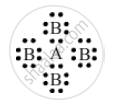Advertisements
Advertisements
Question
An element A has 4 valence electrons in its atom whereas element B has only one valence electron in its atom. The compound formed by A and B does not conduct electricity. What is the nature of chemical bond in the compound formed? Give its electron-dot structure.
Solution
The compound formed by elements A and B has covalent bonds between their atoms. One atom of element A reacts with four atoms of element B to share its one electron.
Its electron-dot structure is represented as:

APPEARS IN
RELATED QUESTIONS
Write structural formula of Methane.
List three characteristic properties of covalent compounds.
State the type of bonding in the following molecule.
Water
Name the element whose one of the allotropic forms is buckminsterfullerene.
Explain the formation of a chlorine molecule on the basis of electronic theory of valency.
Explain why, ionic compounds conduct electricity in solution whereas covalent compounds do not conduct electricity.
Using electron-dot diagrams which show only the outermost shell electrons, show how a molecule of oxygen, O2, is formed from two oxygen atoms. What name is given to this type of bonding? (At. No. of oxygen = 8)
Explain why, diamond is hard while graphite is soft (though both are made of carbon atoms).
what substance is graphite made?
Why is graphite a good conductor of electricity but diamond is a non-conductor of electricity?
The atomic numbers of four elements P, Q, R and S are 6, 10, 12 and 17 respectively. Which two elements can combine to form a covalent compound?
(a) P and R
(b) Q and S
(c) P and S
(d) R and S
You can buy solid air-freshners in shops. Do you think these substance are ionic or covalent? Why?
Which element exhibits the property of catenation to maximum extent and why?
Draw an electron dot structure of the following molecule. (Without showing the circle) :
Ethene
An element L consists of molecules.
What type of bonding is present in the particles that make up L?
An element L consists of molecules.
Why L is heated with iron metal, it forms a compound FeL. What chemical term would you use to describe the change undergone by L?
What are the term defined below?
A bond formed by share pair of electrons, each bonding atom contributing one electron to the pair.
What is the difference between :
Ionic compounds and covalent compounds
Which of the following is the formula of Butanoic acid?
The number of single and double bonds present in a molecule of benzene (C6H6) respectively, are ______.
